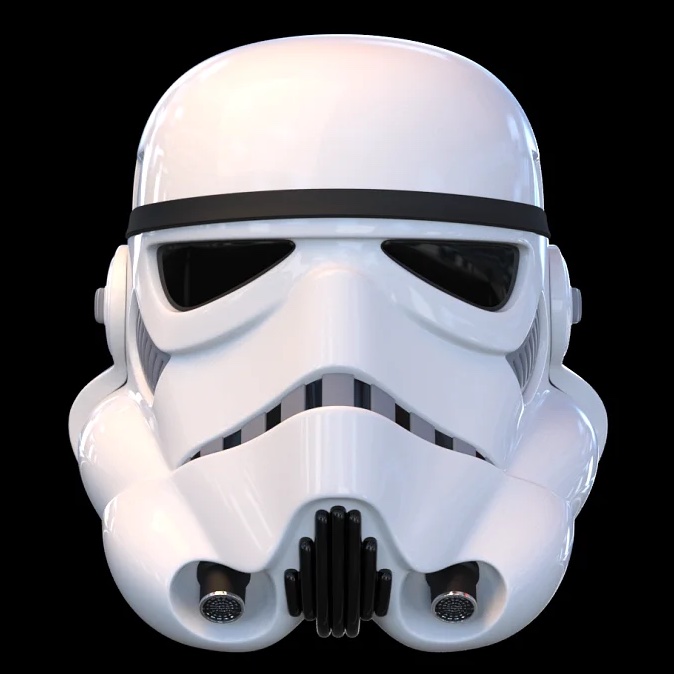Stormtrooper White

The COLOR CODEX series — to which SEMIOVOX has invited our semiotician colleagues from around the world to contribute — explores the unexpected associations evoked for each of us by specific colors found in the material world.
I was 10 years old when the first Star Wars came out in 1977. I was shocked when the bad guys emerged, firing, from the blown hatch of the Tantive IV: they were garbed in gleaming white armour. White! The moral scale rebalanced when Darth Vader shows up in intimidating black, but by then the impact was made on me: high-tech/sci-fi bad guys wear white.
It’s a gloss, plastic-y white: the kind of perfect neutral background color that you never notice; it’s the surface on which real color is applied. Except thanks to Star Wars, I realized it was a deliberate design choice. Star Wars designers John Mollo, Andrew Ainsworth, and Nick Pemberton may have had Kubrick’s 2001: A Space Odyssey in mind, but Stormtrooper White has arguably had an incalculable impact on contemporary packaging and industrial design. To this day, it’s everywhere: any wearable or mobile technology like phones; lots of movies and shows (e.g. Star Wars/Andor, Black Widow, WALL-E, District 9, Tron: Legacy, Prometheus); even automotive (Land Rover Evoque, Nissan Rogue).
So, it’s a deliberate and, by now, a self-conscious design choice: what does it mean? It’s a complex code, about irony and subtlety, misdirection, and optimism. In Western culture, white is purity, morality, honesty; it’s the color of transparency, i.e. the closest color you can get to the idea of the absence of color. But in all contemporary pop culture and technology design contexts, it’s less about the white and more about the play between white and the inevitable black that sits underneath the white. Because — from Stormtroopers to iPhones to the Land Rover Evoque, there’s always black underneath. Black is complexity, technical sophistication, moral ambiguity — but by cladding that black in Stormtrooper White, you’re being reassured: don’t worry about how it works, you’re good — in both senses of the word.
It’s evolved into a knowing wink: the color of transparency, simplicity, and intuitive user-experience for technology that only functions thanks to opacity, complexity, and incomprehensible science. In pop culture media (especially sci-fi) it’s the color for characters who want to be good, or hope they’re good, or want to present as good (‘please, decode me this way’), but who really know they’re not, or that life isn’t that simple, or who constantly struggle with dialectic moral and/or philosophical tension — or at least want you to think they do. Remember: Stormtroopers have feelings too.
COLOR CODEX: Martha Arango (Sweden) on FALUKORV RED | Rachel Lawes (England) on DEVIL GREEN | Audrey Bartis (France) on KYOTO MOSS | Maciej Biedziński (Poland) on SKIN-DEEP ORANGE | Natasha Delliston (England) on MARRAKECH MINT | Whitney Dunlap-Fowler (USA) on RESURRECTION CANARY BLUE | Ximena Tobi (Argentina) on VILLA MISERIA BRICK | Aiyana Gunjan (India) on LETTERBOX RED | Lucia Laurent-Neva (England) on TEAL BLUE VOYAGER | Charles Leech (Canada) on STORMTROOPER WHITE | William Liu (China) on PINING GREEN | Ramona Lyons (USA) on GOTH PURPLE | Greg Rowland (England) on LAUNDROMAT FUTURA | Sónia Marques (Portugal) on RUNAWAY BURRO | Max Matus (Mexico) on CALIFORNIAN BLUE | Chirag Mediratta (Canada / India) on AUROVILLE ORANGE | Alfredo Troncoso (Mexico) on BORGES GLAUQUE | Josh Glenn (USA) on TOLKIEN GREEN | Clio Meurer (Brazil) on PARIS LUMINOUS GREY | Serdar Paktin (Turkey / England) on AMBIENT AMBER | Maria Papanthymou (Russia / Greece) on AGALMATOLITE WHITE | Sarah Johnson (Canada) on ARMY GREEN | Vijay Parthasarathy (USA) on ALPHONSO YELLOW | Tim Spencer (England) on ELECTRO-EROTIC COBALT | Adelina Vaca (Mexico) on MEXICAN PINK.
Also see these global semio series: MAKING SENSE (Q&As) | SEMIOFEST SESSIONS (monthly mini-conferences) | COVID CODES | SEMIO OBJECTS | COLOR CODEX | DECODER (fictional semioticians) | CASE FILE | PHOTO OP | MEDIA DIET.

